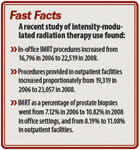Article
Group challenges radiation therapy self-referral charges
Possible new federal self-referral restrictions on radiation therapy services are being aggressively challenged by a nationwide group of integrated group practice physicians who take issue with charges that physician ownership of equipment used in the procedures results in increased and unnecessary services and Medicare costs.

In mid-April, three powerful members of the House of Representatives asked the Government Accountability Office (GAO) to evaluate the extent to which self-referral may have led to increases in the provision of, and Medicare spending for, advanced imaging and radiation oncology services. Those lawmakers were Rep. Henry Waxman (D-CA), chairman of the Energy and Commerce Committee; Rep. Sander Levin (D-MI), chairman of the Ways and Means Committee; and Rep. Pete Stark (D-CA), chairman of the Ways and Means Health Subcommittee.
In a letter to GAO Acting Comptroller General Gene L. Dodaro, they pointed out that the current prohibitions against self-referral provide an "in-office ancillary services exemption (IOAS)" that allows a physician, under certain conditions, to provide imaging services, radiation therapy services, and some other designated health services in the office.

Thus, Access to Integrated Cancer Care (AICC), a group of some 875 physicians in 35 multidisciplinary group practices in 18 states, commissioned Milliman, Inc. (Seattle), an independent actuarial firm, to analyze site-of-service Medicare data to get at the facts. The AICC is led by Dr. Kapoor.
According to Dr. Kapoor, that study refutes the claims of overutilization. Milliman, he said, analyzed the use of intensity-modulated radiation therapy (IMRT) by site of service and clearly showed that utilization of the procedure is not determined by physician ownership.
According to the study, in-office IMRT procedures increased from 16,796 in 2006 to 22,519 in 2008. However, procedures provided in outpatient facilities increased proportionately from 19,319 in 2006 to 23,057 in 2008. IMRT as a percentage of prostate biopsies showed a similar trend: from 7.12% in 2006 to 10.82% in 2008 in office settings, and from 8.19% to 11.08% in outpatient facilities.
"Clearly, there is a trend to more groups incorporating IMRT," Dr. Kapoor said. "But if Congress enacts legislation without cause, you are going to adversely affect a lot of patients."
MedPAC responds
The AICC presented its findings to the Medicare Payment Advisory Commission (MedPAC). Apparently, MedPAC found credibility in the data collected by Milliman, because in its most recent report to Congress in June, MedPAC suggested an "option" to limit the in-office ancillary services exception to physician practices that are considered clinically integrated.
"The goal of this strategy is to balance the risks of higher volume associated with self-referral with the potential benefits of clinically integrated practices, such as the capacity to provide comprehensive and coordinated care," MedPAC wrote. "However, under the current FFS [fee-for-service] payment system, even clinically integrated groups have a financial incentive to increase volume. Thus, Medicare should begin developing new payment models that reward providers for restraining volume growth while improving quality."
MedPAC said a key issue under this approach would be the definition of "clinical integration" in a way that could be measured. It suggested one possible approach would be to require that each physician in the group provide a substantial share of his or her services-such as 90%-through the group.
Currently, the IOAS exception requires that physicians who are members of a group must provide at least 75% of their services through the group, although physicians can provide less than 75%-if the aggregate percent of the group equals or exceeds 75%. Physicians who independently contract with the group are not considered to be "members" of the group and do not count toward the 75% rule.
MedPAC observed that restricting the IOAS exception to clinically integrated groups would limit the number of practices that qualify for the exception, but the groups that qualify would still have a financial incentive to order more ancillary services under the FFS payment system. But it noted that such a restriction could encourage development of integrated practices, which MedPAC said could be "well-positioned to succeed under a new payment model."
Integrated group practices, Dr. Kapoor said, "are much more likely to get modern technology" and provide patients with the most options for their treatment.
Dr. Kapoor said the Milliman data have been presented to AUA, that a meeting has been scheduled with GAO, and that the data will be presented to Congress if there are hearings on any proposed legislative restrictions.
Bob Gatty, a former congressional aide, covers news from Washington for Urology Times.
Newsletter
Stay current with the latest urology news and practice-changing insights — sign up now for the essential updates every urologist needs.
















